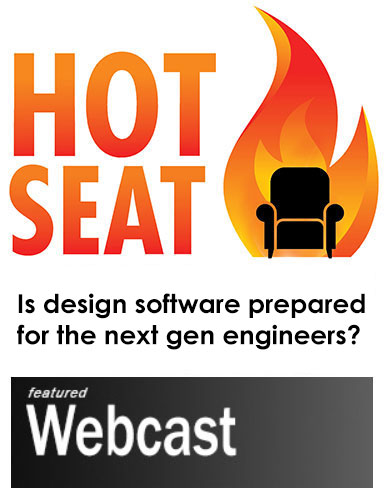COVID-19 Pushes PLM/PDM to the Cloud
From bill of materials and file sharing to collaboration, many functions move to the cloud during lockdown.

Latest News
June 15, 2020
Under normal circumstances, product lifecycle management (PLM) and product data management (PDM) systems keep design files protected, maintain a history of design edits, sync up revisions and provide easy access to approved sources and part suppliers. But these times are anything but normal.
Since January, COVID-19 has now spread worldwide, shutting down projects and disrupting supply chains. During the pandemic, in times of widespread lockdowns and stay-at-home orders, PLM and PDM take on new roles.
Shifting Focus
In late March, Dassault Systèmes, known for its 3DEXPERIENCE software products, launched an online community called Open COVID-19, where “designers, engineers and manufacturers can play a critical role in combatting the COVID-19 pandemic,” it says. The initiative is attached to 3DEXPERIENCELab, where the company showcases its R&D projects.
“What we deliver on the cloud is a combination of collaboration and design tools. The trend is on collaboration right now. Activities around design tools are either decreasing or on hold. The strong increase is clearly on collaboration,” remarks Vincent Frerebeau, director, Worldwide Cloud, Dassault Systèmes.
But collaboration in a crisis is not the same. For instance, the corporate VPNs and firewalls that once helped secure proprietary files may now become a roadblock when employees try to access their design files and bill of materials (BOM) documents from their home computers, unrecognized or unsanctioned by IT.
“There’s a kind of balance between security and collaboration. If you are overly protective of your data, you cannot collaborate. Or you might increase your collaboration, only to find your security is compromised. It’s important to find the right balance. Right now, I notice the desire for collaboration is stronger, and the customers’ preference is to do it via software as a service) or infrastructure as a service systems certified for regulatory compliance. There’s a strong desire to use web-based solutions over VPN,” observes Frerebeau.
Wish I Had My BOM in the Cloud
Oleg Shilovitsky, Vic Sanchez and Christopher Chaulk, all long-time veterans of the PLM industry, run a cloud-hosted BOM product called OpenBOM. The subscriptions run from $25 per month for pro users to $375 per month for companies. Enterprise account pricing is unpublished. The product has tight integration with major CAD systems.
At the end of March, OpenBOM announced it is giving away professional team subscriptions to medical groups working to fight COVID-19.
“I can see many of my friends and industry colleagues are working these days on various manufacturing projects—creating PPE (personal protective equipment), creating unique devices needed in hospitals and more,” writes Shilovitsky. “OpenBOM is a tiny startup, but we also want to bring our contribution to help engineers, contractors and manufacturing companies to fight (the) COVID-19 pandemic.”
Shilovitsky thinks his customers may be better equipped to weather the lockdowns with cloud-based BOMs. “If you had created a BOM of your design and uploaded it and the associated files to OpenBOM before the crisis, then you can still access the information now even if your CAD workstation is inaccessible,” he points out.
Under normal circumstances, you can open your CAD model at any time and export a BOM. But during the crisis, many engineers face a predicament where their CAD workstations are left in their shuttered offices, leaving them unable to work with the design files, the BOM or the associated supplier data. The BOMs hosted in browser-accessible OpenBOM, on the other hand, remain accessible even if the CAD workstation is not.
Where is My Briefcase?
It’ll be a while before engineers pick up their briefcases and laptops to go back to their offices, but one briefcase becomes more important for Teamcenter PLM users during the crisis.
“Teamcenter Briefcase is for sharing data with people who don’t have access to Teamcenter PLM. Normally, this is meant for communicating with suppliers. Now, this can be used by employees working from home,” says Bill Lewis, director of marketing, Siemens Digital Industries Software.
The Briefcase is meant as a collaboration tool to share CAD files and product structures, according to Lewis. “When you open a file in it, it looks like you are opening it from Teamcenter, not from the computer OS. The sender controls what the recipient can and cannot do, like changing the CAD file or product structure. When the sender receives it back, he or she can reject or accept the changes,” Lewis explains.
Typically, Siemens’s design authoring products, such as NX or Solid Edge, are run from desktop workstations with appropriate configurations—certified graphics processing units, CPUs and memory footprint. But during the crisis, a new trend has emerged. Because many are working from home with PCs underequipped to run CAD and simulation programs, remoting and streaming is now a desired solution.
“There are customers we manage on the cloud as a service. For them, we are now offering application streaming from the cloud to their remote desktops,” says Lewis. “The remote solutions are becoming more and more important.”
Remote Training on the Rise
With travel restrictions and lockdowns preventing site visits, PLM vendors and their partners who offer consulting and training are now shifting online to continue to deliver the same services. Razorleaf, a PLM consultant, is among those.
“Everyone is willing to accept some reasonable compromise during the crisis,” says Jonathan Scott, chief architect, Razorleaf. “People will start using the collaboration tools in their PLM systems they didn’t notice before. They’ll see these collaboration capabilities in a new light.” (For more, read “Remaining Productive During Lockdown”).
In mid-March, Razorleaf introduced a manufacturing suite for Aras Innovator platform, designed to automate manufacturing processes. The key modules in the package address change management, supplier management, training management and project management.
PLM vendor Aras’ Founder and CEO Peter Schroer also published an open letter. “Aras Upgrade Service continues and the team is actively reaching out to subscribers to plan and execute upgrades. Upgrades are included in your subscription and cost nothing but time,” the letter stated. “Aras Training is free for subscribers. Classroom training sessions are temporarily on pause. Please take advantage of the online resources in the Subscriber Portal.”
Remoting on the Rise
At the end of March, Mark Reisig, director of product marketing for Aras, published a blog post in response to the crisis. “If there’s a silver lining, it’s that we’ve all been forced to change—to adopt digital processes, virtual meetings and so on—which can expose certain inefficiencies. In many cases, we either do it remotely or it won’t get done,” he wrote (“Adapting to the Unknown”).
Now that project status updates, group discussions and design edits can no longer take place in person, the PLM/PDM tools facilitating this collaboration take on a larger share of the burden.
“Too often, teams use email or spreadsheets to relay information, or worse yet, rely on in-person interactions that are no longer viable during today’s environment. These manual methods are disconnected, error-prone and take effort to connect the dots when organizations should instead be leveraging communications tools that provide a secure, connected and collaborative environment,” observes Reisig.

VR During Social Distancing
Siemens’s Lewis seems to think COVID-19 will push virtual reality (VR) into the mainstream.
“We allow our customers to access VR without data staging or translation. This removes the barrier to VR,” he says. “Now that people cannot work together in the physical environment, some companies are starting to send VR packages off to employees, I heard.”
PTC, which runs an augmented reality (AR) business division under the Vuforia brand, announced in late March it’s offering its AR-powered remote assistance software Vuforia Chalk for free.
“[It] leverages augmented reality to enable offsite and onsite employees to collaborate in the operation, maintenance and repair of all kinds of products. It’s like FaceTime, with augmented reality superpowers for industrial settings … To help during this crisis, we’re making Chalk available for free. No obligations,” the company says.
On March 26, ABI Research published a white paper to examine the effect of COVID-19 on the AR market.
“The coronavirus outbreak will cause manufacturing delays at the source and reduce the overall demand for augmented reality smart glasses. At the same time, there will be a significant increase in demand on both the enterprise and consumer side as telepresence and content demand grows. The balance between these two will see 16 million AR and virtual reality head-mounted display shipments in 2021, maintaining the trajectory of the 3.5 million consumer AR shipments in 2024,” according to the research firm.
More Aras Coverage
More Dassault Systemes Coverage

More PTC Coverage
Subscribe to our FREE magazine, FREE email newsletters or both!
Latest News
About the Author
Kenneth Wong is Digital Engineering’s resident blogger and senior editor. Email him at kennethwong@digitaleng.news or share your thoughts on this article at digitaleng.news/facebook.
Follow DE






